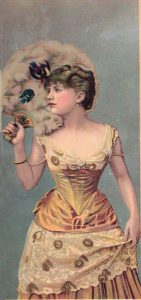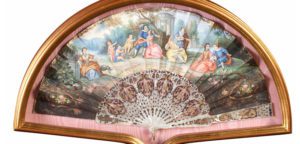The Antiques Addict
By • June 21, 2017 0 1156

Attempts to control indoor temperatures began in ancient Rome, where Seneca, the Stoic philosopher, mocked the “skinny youths” who ate snow to keep cool rather than simply bearing the heat like a real Roman ought to.
A more practical invention was the hand fan, used throughout history to stay cool through the dog days of summer. Fans were also used to quicken the burning of a fire, to keep bothersome insects at bay, as protection from the rain, as a tray for offering or receiving refreshments, for salutations and signals, to punctuate sentences and to hide bad teeth.
The earliest folding fan probably originated in Japan. Adopted in China between 900 and 960, the folding fan was brought to Europe via Portugal during the 15th century.
During the 16th century, folding fans found their way to France with the Italian perfumers, who went there in the train of Catherine de’ Medici. Painted Italian fans were prized not only as decorative items, but as practical ones. If conversation lagged, one could always talk about the image on the fan.

Victorian ladies loved their fans made of peacock feathers. The peacock feather was popular because its eye motif was seen as a protective symbol. Courtesy AVictorian.com.
Sophisticated Italian women began using fans as fashion statements, the fashion spreading throughout Europe, where the styles and construction of fans changed to complement the ever-changing fashions. All the finest skins, known as “chicken-skins” (although the skin was actually treated kid’s skin) were brought from Italy to France. Painted sticks were also much in favor for Italian fans.
By the late 18th century, hand fans represented the most exquisite objects d’art and were the prefect gift for the lady of good taste. Fans became popular during the elaborate masquerade balls held across Europe during that century. A lady’s fan soon became part of a ritual of flirtation.
“Fan languages” evolved as a way to cope with restricted social etiquette. The rules were memorized and practiced by young suitors as well as by the ladies they wooed. For instance, holding a fan in the left hand meant “desired acquaintance,” while twirling the fan in the left hand signified “I wish to be rid of you.” Resting a fan on the right check meant “yes” and on the left “no.”
The popularity of fans led to experimentation in their production and merchandising. Fans often contained concealed mirrors, toiletries, amusing articulated scenes and even weapons. They became the ideal vehicles for advertising; a farmer could learn the benefits of threshing machines. Americans could keep pace with events of the French Revolution by reading the songs and slogans printed on fans. In 1898, American voters kept track of the date with a McKinley fan-calendar.
During the height of the Victorian era, the fan was an indispensable fashion accessory, valued far beyond its use as a way to create cool breezes. Due to the Victorians’ delight in variety, profusion and eclectic ornamentation, blades thickened, partly to support the weight of elaborate textiles and embroidery.
Any fabric or material that could be used was used, from exquisite lace to rubber. The Victorian passion for feathers decimated the world’s bird populations, as fan makers stole plumage from the exotic peacock and the humble turkey. Beautiful ostrich-feather fans came into fashion in the 1880s.
As with any collectible, condition is of prime importance, with mint-condition fans with their original boxes being rare and of great interest to serious collectors. The exception to the condition rule is the fan depicting historical events: battles, coronations, birthdays or marriages of nobility or a world leader. These fans hold their value despite some minor flaws or tears. The sticks and blades are also an important factor in determining value. Those of ivory and mother-of-pearl are the most valuable, as are French fans with highly decorated sticks or fans made by premier makers, like Duvelleroy. American 19th- to 20th-century advertising fans with great graphics are also highly sought by collectors.
Mass-produced late Victorian fans are typically found on the market. Frequently given as a memento of a dance or supper party, these were often autographed by the friends and escort of the owner. A “freebie” of its time, this kind of fan can fetch from $25 to $80 today.
Oriental fans depicting court scenes, with appliquéd silk and small ivory ovals painted with faces, are collectible. These can sell for $140 on up to $5,000, depending on how many ivory oval faces they hold.
Until the advent of electric fans, Americans dealt with the hot weather as many still do around the world: they sweated and fanned themselves with their trusty hand fans.
Michelle Galler is an antiques dealer, a design consultant and a realtor based in Georgetown. Her shop is in Rare Finds, on Main Street in Washington, Virginia. Reach her at antiques.and.whimsies@gmail.com.

